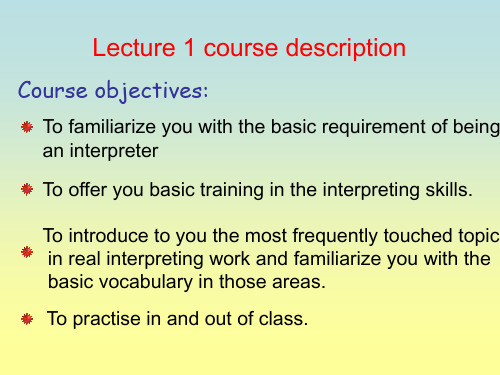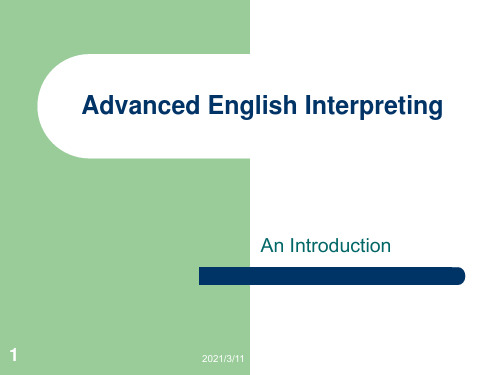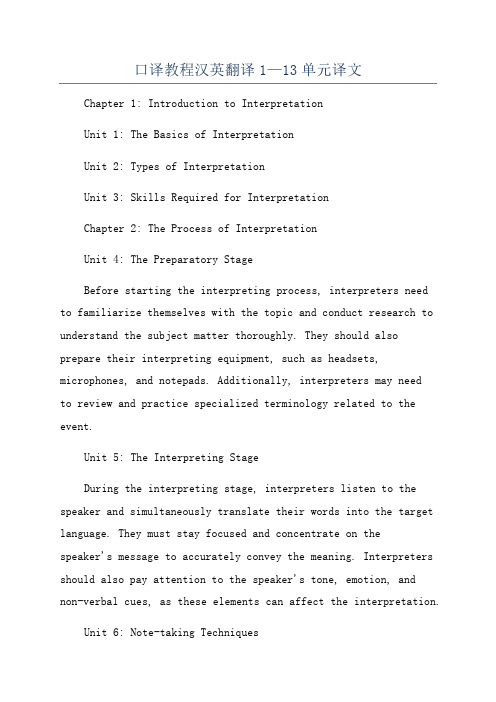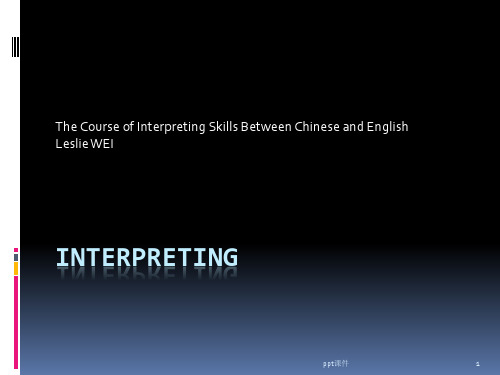英语口译基础教程 1. interpreting course
口译基础

To practise in and out of class.
c 跨文化意识:口译是跨语言、跨文化的交际活动,其 最终目的是要让听众和讲话人达到思想文化的交流。
B 非智力因素
心理素质 身体素质 态度 责任心
IV. Brief History of Conference Interpreting
During the 1919 Paris Peace Conference, CI debuted officially.
II. Why to Be a Professional Interpreter?
4 Goods: Good places to visit Good food to eat Good money to make Good people to meet
III. 口译能力的构成:(Video)
A 智力因素
Textbooks for reference:
《口译基础》,邓轶主编,上海外语教育出版社 《英语口译基础教程》,仲伟合主编,高等教育出版社
Course plan:
Skill-based, topic-oriented
Theory explanation Skill-training Practice
Interpreting as a profession: the foundation of International Association of Conference Interpreters (AIIC) in 1953.
简明商务英语口译教程A Concise Interpreting Course Book for

精品PPT
即学即练:
1.The best artists in the town// were employed// to teach him the art// in which he had shown so much skill.
(我们(wǒ men)的外交大臣有一次以三项我认为现 在还适用的简单原则阐明了我们(wǒ men)的目 标。)
精品PPT
3. Japan surrendered// in 1945// after Americans dropped two atom bombs.
日本投降(tóuxiáng)了,//那是在1945年,//(在这)之前,美 国人投了两颗原子弹。
简明商务英语口译(kǒuyì)教 程
A Concise Interpreting Course Book for
Business English
精品PPT
Unit 1
精品PPT
Section A
Get Your Pronunciation Right
这一部分着重练习英语中字母组合 “con” 的 不同发音,其发音原则是 “ con” 在重音位置 上读作[kɔn] ,在非重音位置上读[kǝn] ,这也 是许多(xǔduō)学生发音失误较多的部分。
2.The shaky voice of terrified acquaintance// told me// that the German troops// would begin the occupation of Bohemia and Moravia.
3.It’s a story// they tell// in the border countryside,// where Massachusetts joins Vermont and New Hampshire.
英语口译基础教程-Unit-1-Introduction

KI=KL+EK+S (P+AP) 译员应该掌握的知识 =双语知识+百科知识 +技能(职业 口译技能 +艺术表达技能 )
– KI=Knowledge Required for an Interpreter – KL=Knowledge for language – EK=Encyclopedic Knowledge – S (P+AP)=Professional Interpreting Skills and
By ways: one-way interpreting 单向口译 two-way interpreting 双向口译
9
2021/3/11
Types of interpreting
By contents: guide interpreting 导游口译 ceremony interpreting 礼仪口译 information interpreting 宣传口译 conference interpreting 会议口译 negotiation interpreting 谈判口译
美 经 中美合企 2年 I 说 dif@bus. man. 中← →美// we 更 直 率 比 中←不同文传// I x 我 bus. ++ 毕 有 + & - @both // 近年 美企exe. 强: hu 中管//
13
2021/3/11
Example 2: How do you interpret?
今晚,我们很高兴在北京大学再次接待我们的老朋友格林博士和夫人。 /我代表学校的全体师生员工向格林博士和夫人及其他新西兰贵宾表示热 烈的欢迎。//
我相信格林博士这次对我校的访问,必将为进一步加强两校的友好合 作关系作出重要的贡献。//
口译教程汉英翻译1—13单元译文

口译教程汉英翻译1—13单元译文Chapter 1: Introduction to InterpretationUnit 1: The Basics of InterpretationUnit 2: Types of InterpretationUnit 3: Skills Required for InterpretationChapter 2: The Process of InterpretationUnit 4: The Preparatory StageBefore starting the interpreting process, interpreters need to familiarize themselves with the topic and conduct research to understand the subject matter thoroughly. They should also prepare their interpreting equipment, such as headsets, microphones, and notepads. Additionally, interpreters may needto review and practice specialized terminology related to the event.Unit 5: The Interpreting StageDuring the interpreting stage, interpreters listen to the speaker and simultaneously translate their words into the target language. They must stay focused and concentrate on thespeaker's message to accurately convey the meaning. Interpreters should also pay attention to the speaker's tone, emotion, and non-verbal cues, as these elements can affect the interpretation.Unit 6: Note-taking TechniquesNote-taking is an essential skill for interpreters.Effective note-taking allows interpreters to retain important information and assist with memory recall during interpretation. Interpreters should develop their own note-taking system and use abbreviations and symbols to jot down key points quickly. However, note-taking should not interfere with active listening and immediate interpretation.Chapter 3: Consecutive InterpretationUnit 7: Introduction to Consecutive InterpretationConsecutive interpretation involves listening to one or several sentences in the source language and then reproducing them in the target language. It requires good memory retention and the ability to accurately convey the meaning. Interpreters should take notes and use their notes as a reference during the interpretation.Unit 8: The Techniques of Consecutive InterpretationInterpreters use several techniques during consecutive interpretation to ensure accurate and fluent delivery. These techniques include paraphrasing, summarizing, clarifying ambiguous statements, and maintaining natural rhythm and pacing. Interpreters should also adapt their interpretation style to match the speaker's tone and style.Unit 9: Consecutive Interpretation PracticeInterpreters can practice consecutive interpretation by engaging in role plays or shadowing experienced interpreters. They can also utilize practice materials, such as speeches, interviews, or articles, to improve their interpretation skills. Regular practice is essential for enhancing memory retention, improving fluency, and perfecting delivery.。
Interpreting英语口译 ppt课件

INTERPRETING
ppt课件
1
Preparation Unit
An introduction to professional interpreting 1. Objectives 2. Overview of course structure 3. Contents of the lessons 4. Overview of interpreting skills 5. Progression of skills
▪ Listening in interpreting is more complex and effortconsuming than the listening comprehension exercises.
▪ An interpreter listens to get the message words carry. While listening, he forms the whole picture of the message, as well as the details.
▪ Coping tactics: reconstitution, skipping and asking
▪ Behaving professionally
ppt课件
6
Progression of Skills for Consecutive Interpreting
▪ Summary: analysis and organization, focus on main points
Memory in CI consists of nothing more than
1周 口译Interpretation(1)

Pair work & Group Performance
The in-class practices are mainly done in pairs. And the whole class will also be divided into several groups. This will take up 20%.
1.4 Course Policies:
Grading Policy: Class work grade is determined by attendance, participation, presentation, group performance and the final exam. Attendance and participation 10 points Presentation 10 points Pair work & Group Performance 20 points Final exam 60 points TOTAL 100 POINTS
1.2 Objective:
The objective is to develop interpreting skills. By the end of the course the students will be able to interpret in professional communication. They will become aware of the role of interpreters as well as the difficulties and subtle nuances involved in bilingual communication in the modern society where there is a constant flow of information.
英语口译基础教程Unit1Introdu

01
Introduction to Interpretation
Definition of Interpretation
It involves comprehending the exact meaning and intention of the source language and expressing it in the target language with accuracy and fluency
Executive Interpretation
The interpreter translates the spooked words of the source language after they have been delivered, either note taking or without notes
Standards for Interpretation
Accuracy
The interpreter must accurately translate the source language into the target language, ensuring that the meaning and intention are fully conveyed.
The interpreter needs to have a good memory to store and recall information during the interpretation process
Language conversion skills
Language comprehension
Unit 1 Interpreting 口译概况

China
Accreditatio
Aptitude Test n
for
Examinatio
Translators ns for
and
Translators
Interpreters and
-CATTI
Interpreters
-NAETI
CATTI
NAETI
上海口译
考试主办机 国家人事部和中 教育部考试中心 上海市委组织部
多为口语化
可查阅,问询, 即时,即席,短
探讨
时记忆
很难见到作者和 理解发言人和听
读者
众的反应
信达雅
准顺快
口译的基本特点
口译工作有时效性和即席性 口译工作有不可预测性和独立性 处理信息内容具有多元性和广泛性 使用语言口语化 译员技能的综合性:听、视、记、写、读、
说、分析、决策、应变
口译的标准
格认证
口译与笔译的异同
相同点: 都需要将一种语言经过理解和重组用另一
种语言表达出来; 翻译者都必须精通两种语言、文化和转换
技巧.
口译与笔译的异同
输入
输出 内容 信息处理 互动 质量标准
笔译
口译
文字,通过阅读,声音画面(偶尔
可反复
文字),通过试
听,往往一次性
文字,可修改 声音难以修改
多为书面语
证书有效期 每3年重新注册 暂无
登记一次,一次 注册有效期3年
暂无
口译的发展前景
在“非全日制就业人员工资指导价位”表 中列出的54种行业里,同声传译以每小时 2000元人民币的价格拔2.1 万元人民币,非英语类是1.8万元人民币。
业内人士称,平均每星期做两次同声翻译, 一年平均50多万RMB。
- 1、下载文档前请自行甄别文档内容的完整性,平台不提供额外的编辑、内容补充、找答案等附加服务。
- 2、"仅部分预览"的文档,不可在线预览部分如存在完整性等问题,可反馈申请退款(可完整预览的文档不适用该条件!)。
- 3、如文档侵犯您的权益,请联系客服反馈,我们会尽快为您处理(人工客服工作时间:9:00-18:30)。
The symbols of the formal establishment of conference interpretation as a profession: The first interpreting school was set up in 1950 in Geneva, Switzerland; AIIC, the International Association of Conference Interpreters, was founded on Nov. 11, 1953 with its Secretariat in Geneva.
b. Dissimilarities The Other Basic Requirements for Interpreters
(1) Acute hearing (to grasp the meaning) (2)A good command of idioms, slang and proverbs, as well as register & appropriateness. (3)Phonetic competence (accent, intonation, stress and rhythms) & public speaking skills (4) Outstanding memory and note-taking ability (5) psychological competence: quick-witted, calm, resourceful (avoid panic and stage fright)
Interpreter’s knowledge structure
KI=KL+EK+S(P+AP) 译员应该掌握的知识 =双语知识+百科知识 +技 能(职业口译技能 +艺术表达技能 ) KI=Knowledge Required for an Interpreter KL=Knowledge for language EK=Encyclopedic Knowledge S(P+AP)= Professional Interpreting Skills and Artistic Presentation Skills
2.2 The Types of Interpreting
1) In terms of form: consecutive interpretation, Differences simultaneous interpretation, sight interቤተ መጻሕፍቲ ባይዱretation
At present, only 10-15% of interpreting in the UN and EU and general international conference is done in CI. In CI, since the interpreter does not start interpreting until the original speaker has stopped, the interpreter has time to analyze the message as a whole. therefore, a higher standard of accuracy, completeness and logic can be accomplished.
* Encyclopedic knowledge * Knowledge relating to the subject matter * Cross-cultural awareness * Strong sense of responsibility and good professional ethics
The oldest and youngest profession.
Two historical events stimulated the development of the profession. The Paris Peace Conference of 1919; The Nuremberg Trials of Nazi war criminals in 1945–46.
Similarities and dissimilarities between translating and interpreting 1)In terms of medium & working environment & time limit: Translation Interpreting
INTERPRETING
Unit One A General Introduction
Today’s Main Teaching Content
1. A general introduction to interpreting 2. A general introduction to this course and the requirements of the course 3. A general introduction to interpreting tests in China
written fairly relaxing
has certain time limits
oral on the spot
spontaneous
2) In terms of process a. Similarities: input → comprehension → output
b. Differences: * Interpreting: receive information → decode → memorize → encode → expression
Interpreting : accuracy and fluency Translation: faithfulness, smoothness and gracefulness
4) In terms of the requirements of translators and interpreters a. Similarities: * Language skills
2. An Introduction to Interpreting
2.1 The Definition of Interpreting
Interpreting is where an interpreter takes a spoken message in one language and repeats it in another.
Between the two World Wars, consecutive interpreting had predominant status.
The first attempt to introduce SI was made shortly before the Second World War. SI was first patented as a technique by IBM in 1926, and its first implementation (in whisper form) was at Geneva in a tentative form in 1927 and, on a larger scale, in the former USSR in 1928 for the Sixth Congress of Comintern. However, it was during the Nuremberg trials of the Nazi war criminals, which were conducted in English, French, Russian, and German that real full-scale simultaneous interpretations was first used. From 1947 onward, simultaneous interpretation had come to stay at the United Nations.
1. Introduction to Interpreting Course
To think about: 1) what is translation? 2) what is interpretation? 3) what's the difference between them? ( Compared with translation, what is the difficulty in interpreting?)
In the years after the Second World War, with the establishment of the United Nations (UN), European Union (EU), Organization of Economic Cooperation and Development (OECD) and many other international organs, there was a growing need for new interpreters to join the ranks of the first generation of highly skilled but untrained conference interpreters.
In the headquarters of the EU in Luxembourg and Brussels, most of the meeting rooms are facilitated with eleven booths for eleven languages (English, French, Spanish, Italian, German, Greek, Dutch, Portuguese, Finnish, Swedish and Danish). The Official languages of the United Nations are the six languages that are used in UN meetings, and in which all official UN documents are written, including: Arabic, Chinese, English, French, Russian, Spanish Several training institutions were founded in Europe. Since then the training institutions for conference interpreter have sprung all over the world.
